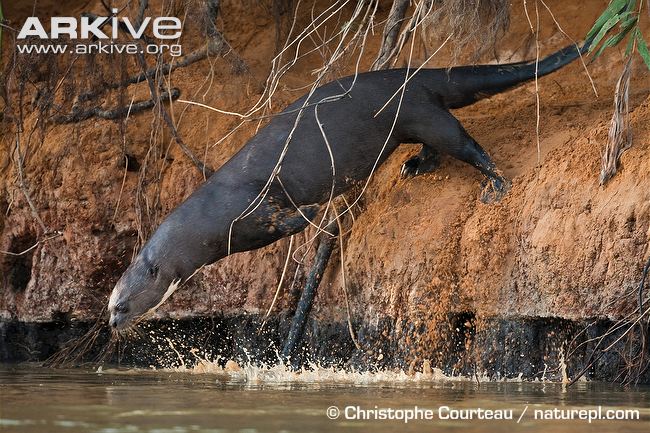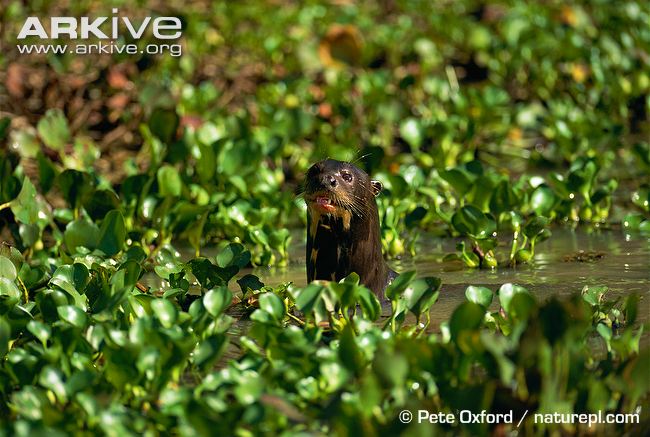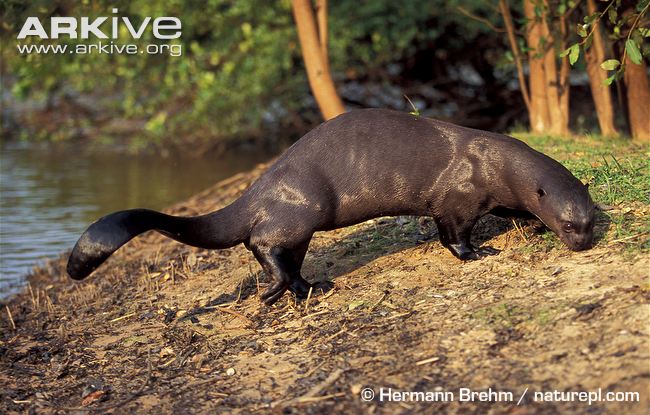Adaptation
The giant river otter is classified as the largest of all otter speices! Because of constant flooding in Brazil, which causes the movement of giant river otters from one territory to another, it's also said to be the most adaptive (Pickles et al. 2011, Rosas et al. 2009). Look below for more information on the giant otters' adapted behaviors and traits.
 The giant river otter lurks on land and water, recognizable with its
abnormally small flat head but long sturdy body. This semi-aquatic
organism has a brown fur coat that allows it to successfully and quickly
move through the water to catch its prey. It also has a strong muscular
tail that propels it through the water. The giant river otter may seem
cute with its adorable rounded ears and webbed feet, which help it to swim
effectively,
but watch out because those webbed feet consist of retractable claws
that aid in the catching and shredding of its prey (Rosas et al.
2009). Another species with similar characteristics to the
Pternonura brasiliensis is the muskrat, with its webbed feet,
strong tail, claws, thick fur to keep warm, and its marsh habitat! To
learn more about the muskrat, visit this
website.
The giant river otter lurks on land and water, recognizable with its
abnormally small flat head but long sturdy body. This semi-aquatic
organism has a brown fur coat that allows it to successfully and quickly
move through the water to catch its prey. It also has a strong muscular
tail that propels it through the water. The giant river otter may seem
cute with its adorable rounded ears and webbed feet, which help it to swim
effectively,
but watch out because those webbed feet consist of retractable claws
that aid in the catching and shredding of its prey (Rosas et al.
2009). Another species with similar characteristics to the
Pternonura brasiliensis is the muskrat, with its webbed feet,
strong tail, claws, thick fur to keep warm, and its marsh habitat! To
learn more about the muskrat, visit this
website.
 Studies show that giant river otters can weigh a maximum of 30 kg, and
their bodies grow no longer than 1.8 meters. Females are considered to
be a little shorter than the males in otter populations, but the female
otters weigh quite a bit more (Rosas et al. 2009). These
numbers can vary based on which individuals and populations are tested. Such a great weight
and length allow the giant otters to maintain body heat throughout the
changing seasons and are used to show dominance against predators.
Studies show that giant river otters can weigh a maximum of 30 kg, and
their bodies grow no longer than 1.8 meters. Females are considered to
be a little shorter than the males in otter populations, but the female
otters weigh quite a bit more (Rosas et al. 2009). These
numbers can vary based on which individuals and populations are tested. Such a great weight
and length allow the giant otters to maintain body heat throughout the
changing seasons and are used to show dominance against predators.
 South America experiences drastic changes in seasons, from wet to dry,
which has caused the giant river otter to adapt a behavior in
response to this environmental stimulus. Otters build dens in the dry
seasons, usually along rivers and ponds, in which the otters keep their
cubs and sleep during the night. However, in the wet seasons, the giant
otter abandons its den and treks across the land, moving from the
riversides and ponds to the flooded forests and swamps. It is here that otters can more adequately catch their fish
because swamps and forests have shallower waters. Although flooding
prevents the ability to build dens, the otters have adapted the knowledge
to build beds out of shrubs (Leuchtenberger et al. 2013).This
constant movement, due to changing of seasons, led to the adaptations of
an even cooler behavior as shown below!
South America experiences drastic changes in seasons, from wet to dry,
which has caused the giant river otter to adapt a behavior in
response to this environmental stimulus. Otters build dens in the dry
seasons, usually along rivers and ponds, in which the otters keep their
cubs and sleep during the night. However, in the wet seasons, the giant
otter abandons its den and treks across the land, moving from the
riversides and ponds to the flooded forests and swamps. It is here that otters can more adequately catch their fish
because swamps and forests have shallower waters. Although flooding
prevents the ability to build dens, the otters have adapted the knowledge
to build beds out of shrubs (Leuchtenberger et al. 2013).This
constant movement, due to changing of seasons, led to the adaptations of
an even cooler behavior as shown below!
 Giant
river otters have adapted the behavior of scent-marking. This behavior
may seem gross to some, but it's actually quite fascinating and
important to the survival of the giant otter as it moves to different
territories. Scent-marking is a process by which the alpha males or
females excrete urine or feces in a certain area in order to mark their
territory, show their sexual maturity and availability, or show
dominance over other predators (Leuchtenberger and Mourao 2009).
Scent-marking takes many forms in which the giant otters can communicate
with each other. This is how females find their mates and males protect
their families against predators.
Giant
river otters have adapted the behavior of scent-marking. This behavior
may seem gross to some, but it's actually quite fascinating and
important to the survival of the giant otter as it moves to different
territories. Scent-marking is a process by which the alpha males or
females excrete urine or feces in a certain area in order to mark their
territory, show their sexual maturity and availability, or show
dominance over other predators (Leuchtenberger and Mourao 2009).
Scent-marking takes many forms in which the giant otters can communicate
with each other. This is how females find their mates and males protect
their families against predators.
If you think the the adaptations of the giant river otters are interesting, just wait! Continue on to the next page to learn about their reproduction.
<Habitat< >Reproduction>